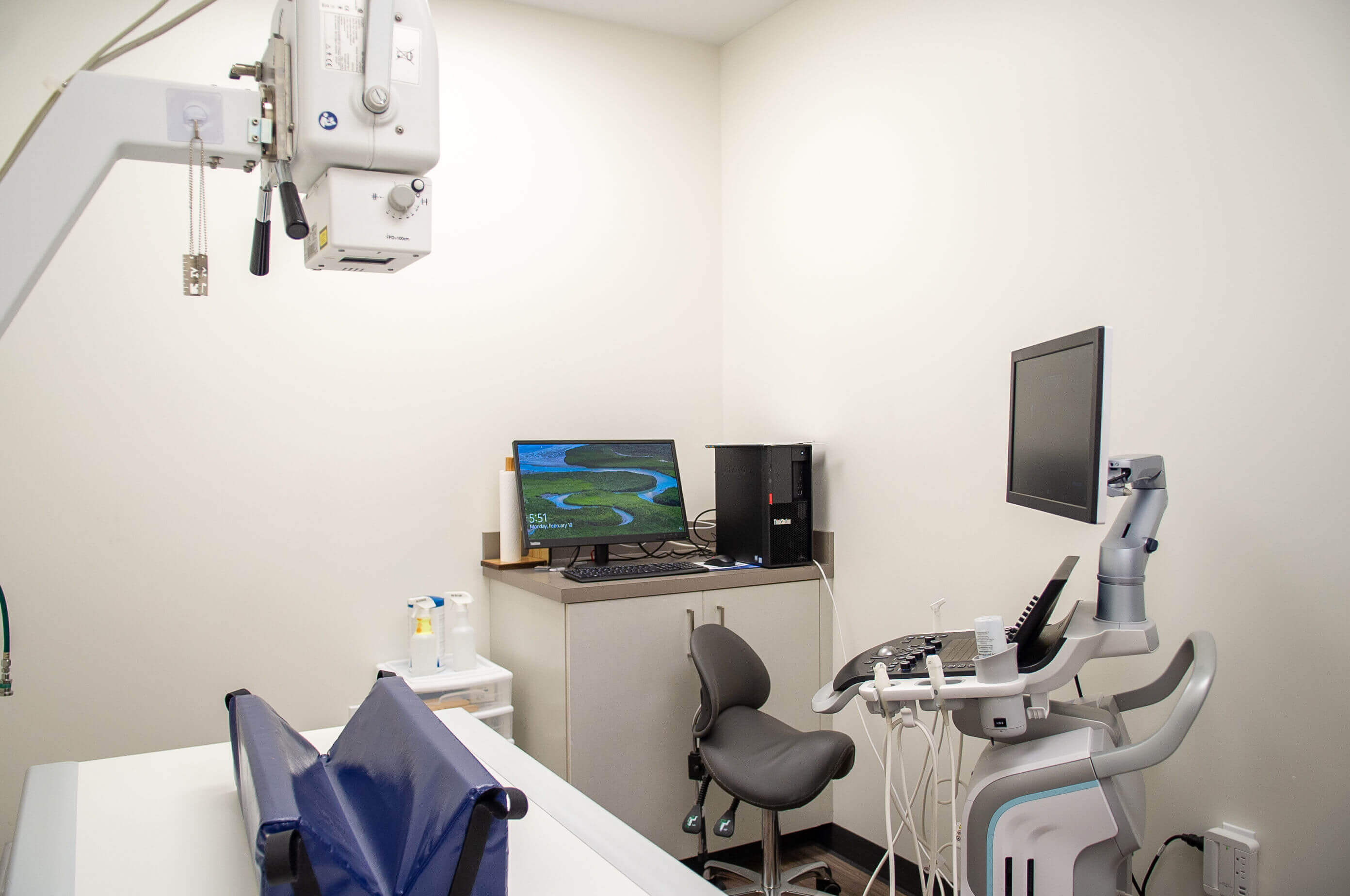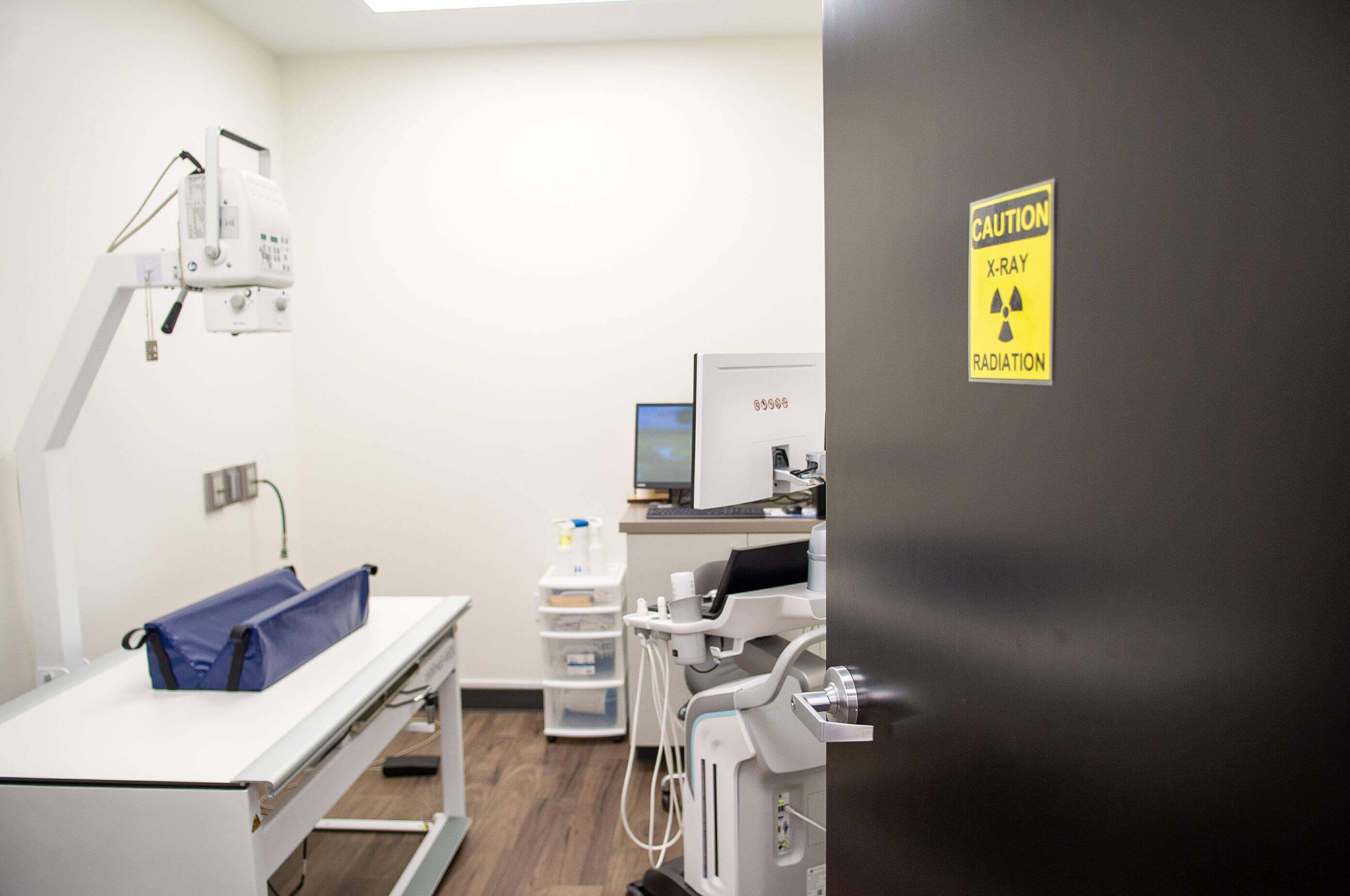What is Veterinary Diagnostic Imaging for Felines?
Veterinary diagnostic imaging includes radiographs (x-rays), ultrasound, MRIs, and CT scans, all of which are used as diagnostic tools to collect information on your cat's health. The vast majority of imaging is non-invasive and easy to perform with gentle handling. However, each cat's individual personality must be considered. At Cat Care Center, we believe in a complete feline friendly approach to anything we do. Cats may become nervous with new experiences, and a percieved threat is real to them. Our team is trained in recognizing the body language and signs of an anxious cat long before stress takes over. We may ask to give them a sedative to help them relax, and in some instances, where absolute stillness is required, anesthesia may be best. Remember, we will always put your cat's needs first and our recommendations will be with their best interest, safety, and diagnostic value of these tests in mind! After all, veterinarians use these images to collect information on your cat to help them to make a medical and sometimes surgical plan.
When is Veterinary Diagnostic Imaging Necessary for Your Cat?
 After our veterinarian has examined your cat, she may want to begin to collect more information that will lead to a diagnosis and treatment plan. X-rays are usually a first line of imaging. The x-ray may lead to a diagnosis, which allows us to move forward with a plan. However, sometimes the next step may be ultrasound to get a more thorough or specific look at a particular area of the body.
After our veterinarian has examined your cat, she may want to begin to collect more information that will lead to a diagnosis and treatment plan. X-rays are usually a first line of imaging. The x-ray may lead to a diagnosis, which allows us to move forward with a plan. However, sometimes the next step may be ultrasound to get a more thorough or specific look at a particular area of the body.
For instance, if your cat is vomiting and feeling ill, you veterinarian may take an x-ray to look for possible causes such as obstruction of intestines or an obvious foreign body. The x-ray may show some signs of an intestinal obstruction, however, before proceeding to surgery, it would be prudent in some cases to follow with an abdominal ultrasound. The ultrasound will give more detail of the area, and therefore allow more confidence of the treatment plan to move forward with surgery. Occasionally, x-rays and ultrasound allow for a definitive diagnosis but other times they will simply add more information to help put the puzzle together for the best treatment plan for your cat.
The four types of Veterinary Diagnostic Imaging our veterinarians may utilize to assist in diagnosis of your cat's condition are:
- X-Rays
- MRIs
- Ultrasounds
- CT Scans
More information on each of these types of radiographs is provided below.
Cat X-Rays
Cat x-rays have been in use throughout the medical community for many decades. Cat x-rays are by far the most regularly used form of diagnostic imaging in the veterinary industry because they are cost effective (comparatively speaking) and they can accurately diagnose the state of skeletal structure and composition, large body cavities, and the presence of many foreign objects. Cat x-rays are totally painless, but some cats can benefit from sedation to reduce anxiety and stress.
 Cat x-rays usually proceed as follows:
Cat x-rays usually proceed as follows:
- We assess your cat's condition and determine what materials we can place on the x-ray table to make sure we provide maximum comfort (a soft padded surface)
- The cat is gently placed on the x-ray table
- A technician positions the x-ray machine so that the x-ray beam targets only the area of interest
- Modern x-ray equipment allows for low levels of radiation and when used only occasionally are perfectly safe for your cat
- Because cat x-rays are static images, the procedure usually requires less time than a procedure like an MRI
Cat x-rays have traditionally been captured on actual film, and still can be when necessary. However, our x-ray images are now digital which allows us to capture the images on a secure server that our veterinarians can access at any time and can also share with specialists if necessary.
Cat Ultrasounds
A cat ultrasound is the second most common type of diagnostic imaging tool veterinarians use to diagnose a cat's medical condition. Ultrasounds use sound waves to examine and photograph internal tissues in real time. An ultrasound allows a veterinarian to see into a cat's body, allowing for easy viewing of organs from different angles that are not easily achieved through x-rays. The function of various organs can be observed to determine if they are malfunctioning. Cat ultrasounds are totally painless, but some cats can benefit from sedation to reduce anxiety and stress.
 A cat ultrasound procedure usually proceeds as follows:
A cat ultrasound procedure usually proceeds as follows:
- The ultrasound surface is layered with warm towels sprayed with Feliway, and soft lighting is used for your cat's comfort
- The area of interest will need to be shaved closely to the skin for a maximum quality ultrasound (we will be gentle and use quiet clippers)
- Our veterinarian gently presses a small probe against the cat's body that emits digital sound waves
- The sound waves are directed to various parts of the cat's abdominal area by manually shifting the probe's position
- The sound beam changes velocity while passing through varying body tissue density, which causes echoes
- Our ultrasound equipment converts these echoes into electrical impulses that are then further transformed into a digital image that represents the appearance of the tissues
- These images can be viewed in real time by a veterinarian, as well as stored for further review at any time
In modern scanning systems like the ones Cat Care Center of Baton Rouge has on-site and uses on our feline patients, the sound beam sweeps through the body many times per second. This produces a dynamic, real-time image that changes as the cat ultrasound device moves across a cat's body. We can use the results of an ultrasound to determine what is ailing your cat and to devise the most effective treatment protocol.
Common symptoms that may cause a veterinarian to use ultrasound include: vomiting, weight loss, kidney impairment or blockage, and heart disease.
Cat MRI
Magnetic resonance imaging, or MRI, is the newest form of diagnostic imaging being used for both human and veterinary medicine. Cat MRI equipment generates a very powerful magnetic field, resulting in detailed anatomic images of whatever part of a cat's body is being scanned. No x-rays are involved, and a cat MRI is considered extremely safe.
A cat MRI procedure usually proceeds as follows:
The cat's body is continuously pulsed with radio waves for a period of time, usually 10-20 minutes
- Cats must be sedated for this procedure because they cannot be held by humans and must remain still during the procedure
- For the procedure, a cat is placed in a tubular electromagnetic chamber
- The pulsing causes the cat's body tissues to emit radio frequency waves that can be detected by the MRI equipment. Many repetitions of these pulses and subsequent emissions are required in order to generate adequate digital feedback for the equipment to interpret.
- The feedback is then converted into images that can be displayed on a screen and can also be saved for future study
A cat MRI is not used as regularly as an x-ray or ultrasound because the equipment is very expensive, very large, and requires specially trained technicians to operate. If Cat Care Center of Baton Rouge feels this procedure is necessary, Dr. Lacie works closely with the neurologist at Baton Rouge Veterinary Specialists and can get this procedure scheduled and performed with your cats best interest at heart.
Cat CT Scans
CT scans for cats, also known as "cat scans," are computer enhanced cat x-ray procedures most often used to evaluate complex parts of the body, such as the head, chest, some joints, and various internal organs. CT scans show different levels of tissue density and produce more detailed images than x-rays. Unlike MRI's, CT scans for cats do not use magnetic field waves so they cannot compare changes in fluid levels due to inflammation or bleeding. Therefore, CT scans for cats are used in situations where an MRI is considered unecessary but a traditional x-ray is inconclusive or insufficient.
CT scans for cats usually proceed as follows:
- Cats must be sedated for this procedure because they cannot be held by humans and must remain still during the procedure
- The cat is placed on a motorized bed inside of a CT scanner, a machine that takes a series of x-rays from various angles*
- When one series, or scan, is completed, the bed moves forward, and another scan is taken
- A computer uses these scans to create cross-sectional images of the body part under investigation and then display the images on a monitor (an x-ray dye may be injected intravenously to make it easier to see abnormalities)
- By sequentially scanning an entire body area, an organ or other structure can be imaged without invasively penetrating the body, or disrupting neighboring structures
CT scans for cats are most often used by our veterinarian to detect structural changes deep within a cat's body, including:
- Tumors
- Some ear diseases
- Lung disease
- Deep abscesses or foreign body presence
- Fractures
In our mission to make sure all diagnostic imaging tools are available for your beloved feline companion, CT scans can be provided for cats at Baton Rouge Veterinary Specialists.
How Feline Radiographs Influence Veterinary Recommendations
The goal of feline radiographs is to ascertain a diagnosis or obtain a final answer without having to perform further, more invasive tests or procedures. For example, an x-ray might show evidence of a tumor of the spine and possibly involve the surrounding muscle. The addition of an MRI would reveal the specific tumor and the extent that the tumor extends into the surrounding muscle tissue. This type of information is very important for a prognosis and treatment plan.
Veterinary diagnostic imaging offers an array of incredibly useful tools within a veterinarian's toolkit. Sometimes a diagnostic imaging session can lead to the need for further diagnostics.
If you are concerned that your cat might be injured or experiencing internal problems, or to discuss how feline radiographs can benefit them, please contact us to schedule an appointment with our veterinarian today.
